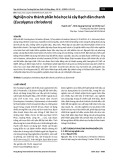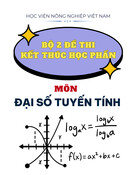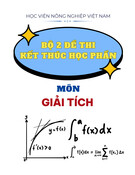
HPU2. Nat. Sci. Tech. Vol 02, issue 01 (2023), 38-45
HPU2 Journal of Sciences:
Natural Sciences and Technology
journal homepage: https://sj.hpu2.edu.vn
Article type: Research article
Received date: 07-4-2023 ; Revised date: 24-4-2023 ; Accepted date: 24-4-2023
This is licensed under the CC BY-NC-ND 4.0
Chemical compositions and anti-acetylcholinesterase, nitric oxide
suppressing activities of Piper longum fruits oil
Thuy-Van Do Thia, Thu-Hoa Nguyen Thia, Anh-Hung Nguyenb, Ngoc-Bich Tran Thia,*
aDepartment of Chemistry, The University of Danang-University of Science and Education, 459 Ton Duc Thang,
Da Nang, Vietnam
bDepartment of Chemistry Hanoi Pedagogical University 2, 32 Nguyen Van Linh, Phuc Yen, Vinh Phuc, Vietnam
Abstract
Piper longum fruits oil in Binh Dinh, Vietnam was obtained via steam distillation with oil collection
efficiency reaching 1.01%. The chemical compositions of the essential oil from Piper longum fruits in
Binh Dinh, Vietnam is determined via the GC-MS method that includes 35 components (99.68%),
among which the main components are caryophyllene (10.78%), 3-heptadecene (9.95%), zingiberene
(9.54%), germacrene D (8.96%), pentadecane (8.76%), heptadecane (8.73%), β-bisabolene (5.98%),
humulene (5.80%), (E)-5-tetradecene (2.73%), α-bisabolene (2.47%), tridecane (2.35%). The essential
oil of Piper longum in Binh Dinh, Vietnam also showed weak anti-acetylcholinesterase activity with
IC50 (µg/mL) = 164.55±13.79 compared to galantamine as a positive control and potent nitric oxide
suppressing activity with IC50 (µg/mL) = 13.02±0.29 compared to dexamethasone as a positive
control.
Keywords: Piper longum oil, Piper longum, steam distillation, anti-acetylcholinesterase, nitric oxide
suppressing;
1. Introduction
Piper longum (Piperaceae) is native to the Indo-Malaya region and widely distributed in the
tropical and subtropical world, including the Indian subcontinent, Sri Lanka, the Middle East, and
America (Manoj P et al., 2004). In Vietnam, Piper longum is commonly known as long pepper,
tarpaulin, or purple pepper leaf (Loi DT, 2003). The fruits are mainly used as culinary spices,
preservatives, and potent remedies in various traditional medicinal systems against bronchitis, cough,
cold, snakebite, scorpion-sting, and contraceptives. Various bioactive phytochemicals, including
* Corresponding author, E-mail: ttnbich@ued.udn.vn
https://doi.org/10.56764/hpu2.jos.2023.1.2.38-45

HPU2. Nat. Sci. Tech. 2023, 2(1), 38-45
https://sj.hpu2.edu.vn 39
alkaloids, flavonoids, esters, and steroids, were identified from the plant extracts. Essential oils from
the roots and fruits were reported as antimicrobial, antiparasitic, anthelminthic, mosquito-larvicidal,
anti-inflammatory, analgesic, antioxidant, anticancer, neuro-pharmacological, antihyperglycaemic,
hepato-protective, antihyperlipidaemic, antiangiogenic, immunomodulatory, antiarthritic, antiulcer,
antiasthmatic, cardioprotective, and anti-snake-venom agents (Zaveri M et al., 2010; Grover M et al.,
2021). Many of its pharmacological properties were attributed to its antioxidative and anti-
inflammatory effects and its ability to modulate several signaling pathways and enzymes (Biswas P et
al., 2022).
Alzheimer's disease is a devastating neurodegenerative disorder with grave concerns in the
elderly. The disease is characterized by the deposition of amyloid-β plaques and neurofibrillary tangles
in the brain, accompanied by synaptic dysfunction and neurodegeneration. Due to the required long-
term care and management, this seriously impacts the patient's health and quality of life and burdens
the family and society. It has been demonstrated that the neuropsychological impairments of
Alzheimer's disease are attributed, at least partially, to cholinergic disturbance. Rivastigmine and
galanthamine derived from natural products are commonly prescribed cholinergic enhancers as
acetylcholinesterase (AChE) inhibitors (Xiang CP et al., 2017). Nitric oxide is an endogenous free
radical species that is synthesized from L-arginine by nitric oxide synthase in various animal cells and
tissues. Small amounts of nitric oxide are essential regulators of physical homeostasis, whereas more
significant amounts have been closely correlated with the pathophysiology of various diseases and
inflammation. After exposure to inducers, such as lipopolysaccharide from gram-negative bacteria,
inducible nitric oxide synthase can be induced in various cells, such as macrophages, Kupffer cells,
smooth muscle cells, and hepatocytes, thereby triggering cytotoxicity, tissue damage, inflammation,
sepsis, and stroke. Thus, measuring NO production may be a method for assessing the anti-
inflammatory effects of plant extracts (Tung YT et al., 2010). Aromatic plants have been used to cure
neuronal ailments and anti-inflammatory for centuries by different cultures worldwide. Such plant's
essential oils and volatile compounds might be potential drugs for Alzheimer's disease therapies and
nitric oxide suppressing.
Many species of Piper plants are widely used as dietary spices in cuisine worldwide due to their
delicious and unique taste (Xiang CP et al., 2017). There are several studies on the chemical
compositions and biological activities of Piper longum fruits oil worldwide (Shankaracharya NB et
al., 1997; Tewtrakul S et al., 2000; Varughese T et al., 2016) and Vietnam (Lan TTN, 2012).
However, there have been no published on Piper longum fruits oil's anti-acetylcholinesterase and nitric
oxide suppressing activities both in the world and Vietnam.
The present study aimed to determine the chemical compositions and anti-acetylcholinesterase,
nitric oxide suppressing activities of Piper longum fruits oil collected from Binh Dinh, Vietnam.
2. Materials and methods
2.1. Materials
The fruits of Piper longum were collected at Binh Dinh, Vietnam in June 2020. The sample used
for steam distillation is of uniform quality and without spoilage and stored in a cool place. After
harvesting, the sample is processed with preliminary treatment, removed impurities washed, and
pureed before essential oil extraction. Its scientific name was identified by Dr. Quang-Dan Tran,
Department of Biology&Environmental Science, University of Danang-University of Science and
Education. A voucher specimen No. PL001 was deposited at the Department of Chemistry, University

HPU2. Nat. Sci. Tech. 2023, 2(1), 38-45
https://sj.hpu2.edu.vn 40
of Danang-University of Science and Education.
2.2. The steam distillation method
Piper longum fruits oil was obtained by steam distillation with light Clevender with 100 g Piper
longum fruits/400 mL distilled water in three hours at the Chemistry laboratory, University of Danang-
University of Science and Education. The experiment was repeated three times.
The oil collection efficiency is calculated according to the amount of essential oil in the raw
materials, which is determined by the formula:
Y (%)= V×d
m × 100
In which: Y(%): The oil collection efficiency; V (mL): Volume of essential oil; d (g/cm3):
Specific gravity of Piper longum fruits oil, d = 0.8452; m (g): Weight of the fruits of Piper longum.
2.3. Analysis of the chemical compositions
The chemical compositions of the essential oil from Piper longum fruits are determined via the
GC-MS method with GC-MS equipment (GC 7890A, MS 5975C-Agilent).
For GC: Operating temperature: 35oC-450oC, temperature resolution: 1oC, maximum heating
speed: 0.1oC-120oC/min, the maximum run time for sample: 999.99 minutes, speed line: 1-13 mL/min
for Helium, column type: HP-5MS (Length: 30 m, diameter: 0.25 mm, film: 0.25 μm).
For MS: EI with m/z: 20 – 500 amu, retention time repeatability with a trace: < 0.0012 min, area
repeatability with a trace: < 2.0 RSD. The percentage of a compound is based on the ratio of
compound pick area to total pick area.
2.4. Determine the anti-acetylcholinesterase activity
The test was performed according to the method of Ellman GL et al., 1961.
The method is carried out according to the principle: Acetylcholinesterase (AChE) is a catalyst
for the hydrolysis reaction acetylthiocholine iodide (ACTI) produces thiocholin. The thiocholin will
react with DTNB (acid 5-5’-dithiobis-2-nitrobenzoic) to form a yellow 5-thio-2-nitro benzoic acid.
The amount of this color compound is proportional to AChE activity.
2.5. Determine the nitric oxide suppressing activity
The test was performed according to the method of Cheenpracha S et al., 2010 with RAW 264.7
cell line by Prof. Dr. Domenico Delfino, University of Perugia, Italy, and Prof. Dr. Chi-Huang,
National Yang-Ming University, Taiwan.
3. Results and discussion
3.1. The oil collection efficiency
The result of the Piper longum fruits oil collection efficiency is presented in Table 1. The
essential oil of Piper longum fruits in Binh Dinh, Vietnam was obtained via the steam distillation
method with an oil collection efficiency of 1.01% in 100 g Piper longum fruits/400 mL distilled water
for three hours.
The oil collection efficiency of Piper longum fruits oil in Binh Dinh, Vietnam was higher than
that in Binh Duong, Vietnam (an oil collection efficiency of 0.43% in 200 g Piper longum fruits/1000
mL distilled water for ten hours) (Lan TTN, 2012). Differences in seed quality, growing method,
climatic conditions, soil, and growing period can lead to differences in the amount of oil between
localities.

HPU2. Nat. Sci. Tech. 2023, 2(1), 38-45
https://sj.hpu2.edu.vn 41
Table 1. The Piper longum fruits oil collection efficiency
m (g)
Va (mL)
Y (%)
100
1.2
1.01
aThe experiment was repeated three times, and the average
volume was calculated.
3.2. The chemical compositions
The result of the chemical compositions of Piper longum fruits oil is presented in Figure 1 and
Table 2. The chemical compositions of the essential oil from Piper longum fruits in Binh Dinh,
Vietnam is determined via the GC-MS method that includes 35 components (99.68%), among which
the main components are caryophyllene (10.78%), 3-heptadecene (9.95%), zingiberene (9.54%),
germacrene D (8.96%), pentadecane (8.76%), heptadecane (8.73%), β-bisabolene (5.98%), humulene
(5.80%), (E)-5-tetradecene (2.73%), α-bisabolene (2.47%), and tridecane (2.35%). This result is
consistent with the published chemical compositions of Piper longum fruits oil in Vietnam (Lan TTN,
2012) and the world (Shankaracharya NB et al., 1997; Tewtrakul S et al., 2000; Varughese T et al.,
2016).
Figure 1. GC-MS spectrum of Piper longum fruits oil
Table 2. The chemical compositions of Piper longum fruits oil
Retention (RT)
Compounds
Area (%)
8.434
α-Pinene
0.20
9.639
β-Pinene
0.17
11.280
D-Limonene
0.18
11.549
trans-β-Ocimene
0.19
11.879
β-Ocimene
0.25
19.106
(E)-5-Tridecene
0.34
19.521
Tridecane
2.35
20.339
δ-Elemene
0.15

HPU2. Nat. Sci. Tech. 2023, 2(1), 38-45
https://sj.hpu2.edu.vn 42
21.362
Copaene
0.20
21.693
β-Elemene
1.06
22.303
trans-α-Bergamotene
0.45
22.394
Caryophyllene
10.78
22.462
α-Santalene
0.19
22.844
cis-α-Bergamotene
0.69
23.201
Humulene
5.80
23.260
cis-β-Farnesene
1.76
23.377
β-Santalene
0.13
23.84
Germacrene D
8.96
23.963
α-Selinene
1.79
24.045
(E)-5-Tetradecene
2.73
24.173
Zingiberene
9.54
24.306
cis-α-Bisabolene
1.90
24.435
β-Bisabolene
5.98
24.470
Pentadecane
8.76
24.555
α-Panasinsene
1.32
24.628
Sesquisabinene
0.81
24.742
γ-Bisabolene
0.99
24.873
α-Bisabolene
2.47
25.222
Caryophyllene oxide
0.67
26.054
1-Heptadecene
7.15
26.103
3-Heptadecene
9.95
26.189
Heptadecane
8.73
26.958
9-Nonadecene
0.82
26.991
1-Nonadecene
1.54
27.037
Nonadecane
0.68
Total
99.68
3.3. The anti-acetylcholinesterase activity
The result of the anti-acetylcholinesterase activity of Piper longum fruits oil is presented in Table
3. The essential oil of Piper longum fruits showed anti-acetylcholinesterase activity with IC50 (µg/mL)
= 164.55±13.79. Compared with the results about the anti-acetylcholinesterase activity of galantamine,


![Bài tập Hóa lý dược [mới nhất]](https://cdn.tailieu.vn/images/document/thumbnail/2025/20250717/0609anhle@gmail.com/135x160/87091752738236.jpg)























